Most Americans want to buy sustainable products. But it isn’t easy to separate the green from the greenwashed. Even though marketing studies show that 78% of Americans believe companies should be environmentally responsible and 64% say they feel happy when buying sustainable products, a classic consumer protection study found that nearly all green marketing claims are either false or potentially misleading. People who are determined to find more sustainable products have a lot of work to do to educate themselves and shop their values. But even so, is it possible to find the real green thing?
Greenwashing
Greenwashing takes advantage of consumers’ limited time to convince consumers the product is more sustainable than it really is, making people feel better about their products instead of making their products better. This is illegal when they go so far as to make verifiably false environmental claims but the Federal Trade Commission, which is responsible for enforcement, has filed only two to five environmental marketing cases per year since 2015, which means that very few false-green advertisers are ever held accountable. And it’s easy to mislead without telling a lie. Most greenwashing creates a false impression without actually breaking the law. That means it’s up to consumers themselves to spot the red flags of greenwashing.
Is the product marketed with labels making a single environmental claim? If so, there are probably hidden trade-offs. Do they explain the basis for their claim or provide ways to confirm it? If a claim is unsubstantiated, it’s probably greenwashed. Likewise, if the claim is too vague to measure, or if it is true for all products of the same type, then the claim is irrelevant, and it’s greenwashing. Similarly, if a product is the greenest of its type, but the entire product category is inherently harmful, marketing it with environmental claims is still greenwashing.

Realistic Expectations
Unfortunately, it’s a lot easier to identify greenwashed products than to find green ones. In fact, there really isn’t such a thing as a truly sustainable product. Some companies have achieved Zero Waste, but so far, corporate pledges to achieve carbon neutrality or even become resource-positive are just promises, or worse, greenwashing.
For example, Estée Lauder Companies (ELC) has announced that it has achieved Net Zero emissions. The company has sourced 100% renewable electricity and offsets the carbon footprint of its supply chain by purchasing carbon credits. These are significant achievements. But closer scrutiny reveals that the company has a long way to go to reach true carbon neutrality.
The truth is that every product has an environmental footprint. As often as not, the best thing available may not be very good at all.
But there are many companies that strive to minimize their impact and offer products that are significantly better than other choices. Our goal as consumers is to find the products with the smallest footprint and support the companies that are genuinely working to do better, ideally, without overstating their achievements.
Finding True Green
You can take a few steps to confirm that a product is truly greener than the alternatives. The easiest is to learn your ecolabels. There are a lot of ecolabel programs for all kinds of products, from mattresses to seafood and so much more, but they are not all created equal. Some certification programs are themselves little more than greenwashing. You may not be able to research every certification system. But try to learn about those that are relevant to your major purchases and smaller, more frequent purchases. The label’s own website should be clear about its standards, and websites like Earth911 are useful resources for familiarizing yourself with the different types of labels you may encounter.
As a general rule, third-party certifications are more valuable than self-certification or industry-sponsored systems. Look for labels like Green Seal that have standards for multiple environmental attributes or sustainable practices. These can indicate a more significant sustainability effort than single-attribute ones like 100% Recycled.
Ultimately, product labels can only take you so far. Whenever possible, take the time to verify the information on the package or in the ad. Check certification websites to confirm that they list the product as certified or the manufacturer as a participant. Follow up with research on specific claims when there is no certification.
Finally, ask yourself before you buy, “Is this purchase really necessary?” Many products are inherently harmful. Every product has an environmental impact, even when all the claims are true. With a little reflection, you will often find that the real green thing is avoiding a purchase.
This is the final article in a six-part series that includes the following topics:
- What Is Greenwashing?
- How to Spot Greenwashing
- Uncovering Greenwashing: Vague Promises & Irrelevance
- Greenwashing: The Lesser of Two Evils
- Greenwashing: Untruth in Advertising
Feature image courtesy of Larisa-K, Pixabay
The post Finding the Real Green Thing appeared first on Earth 911.








